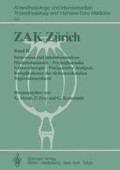Zusammenfassung
Das pharmakokinetische Modell der Inhalationsnarkose wird durch die Alveolarmembran in natürlicher Weise in 2 Anteile zerlegt: das gasführende, präalveoläre System, das die Atemwege und das apparative Beatmungssystem umfaßt und das blutführende „postalveoläre“System. Die kinetischen Parameter des präalveolären Systems (Abb. 1) wie Flow, Ventilation, Totraum, inspiratorische Konzentrationen können in weiten Grenzen vom Anästhesisten frei gewählt werden. Die Gesamtventilation und der unmittelbare Pharmakoninput in das System bestimmen das Pharmakonangebot an der Alveolarmembran. Dieser unmittelbare Input wird bestimmt durch den Verdampferoutput und den Anteil der Rückatmung. Bei der Rückatmung hat man ein Kontinuum von Möglichkeiten: vom Nichtrückatmungs-system über das Teilrückatmungssystem bis hin zum geschlossenen System.
Access this chapter
Tax calculation will be finalised at checkout
Purchases are for personal use only
Preview
Unable to display preview. Download preview PDF.
Literatur
Cork RC, Vaughan RW, Bentley JB (1981) General anesthesia for morbidly obese patients — an examination of postoperative outcomes. Anesthesiology 54:310
Davis NR, Mapleson WW (1981) Structure and quantification of a physiological model of the distribution of injected agents and inhaled anaesthetics. Br J Anaesth 53:399
Eger II EJ (1974) Anesthetic uptake and action. Williams & Wilkins, Baltimore
Kety SS (1951) The theory and application of the exchange of inert gas at the lungs and tissues. Pharmacol Rev 1:1
Sch wilden H, Stoeckel H, Schüttlet J, Lauven PM (1982) Pharmacokinetic data of fentanyl, midazolam and enflurane as obtained by a new method for arbitrary schemes of administration. In: Prys-Roberts C, Vickers MD (eds) European Academy of Anaesthesiology, Proceedings 1981. Springer, Berlin Heidelberg New York
Zuntz N (1897) Zur Pathogenese und Therapie der durch rasche Luftdruckänderungen erzeugten Krankheiten. Fortschr Med 15:632
Editor information
Editors and Affiliations
Rights and permissions
Copyright information
© 1986 Springer-Verlag Berlin Heidelberg
About this paper
Cite this paper
Schwilden, H., Stoeckel, H. (1986). Pharmakokinetik der Inhalationsanästhesie. In: Hossli, G., Frey, P., Kreienbühl, G. (eds) ZAK Zürich. Anaesthesiologie und Intensivmedizin / Anaesthesiology and Intensive Care Medicine, vol 188. Springer, Berlin, Heidelberg. https://doi.org/10.1007/978-3-642-71269-2_16
Download citation
DOI: https://doi.org/10.1007/978-3-642-71269-2_16
Publisher Name: Springer, Berlin, Heidelberg
Print ISBN: 978-3-540-16618-4
Online ISBN: 978-3-642-71269-2
eBook Packages: Springer Book Archive

